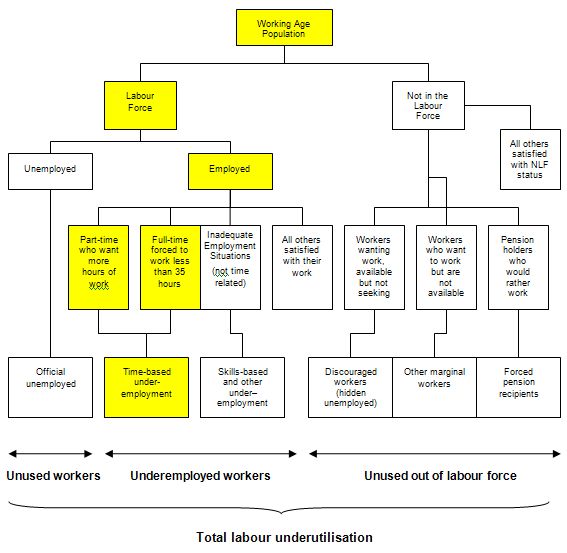
The latest Australian Bureau of Statistics data shows that total hours worked in June 2010 fell while part-time employment (and total employment) grew. Unemployment stayed more or less constant. This signals rising underemployment.
Answer: Maybe
The answer is Maybe.
If you didn't get this correct then it is likely you lack an understanding of the labour force framework which is used by all national statistical offices.
The labour force framework is the foundation for cross-country comparisons of labour market data. The framework is made operational through the International Labour Organization (ILO) and its International Conference of Labour Statisticians (ICLS). These conferences and expert meetings develop the guidelines or norms for implementing the labour force framework and generating the national labour force data.
The rules contained within the labour force framework generally have the following features:
The system of priority rules are applied such that labour force activities take precedence over non-labour force activities and working or having a job (employment) takes precedence over looking for work (unemployment). Also, as with most statistical measurements of activity, employment in the informal sectors, or black-market economy, is outside the scope of activity measures.
Paid activities take precedence over unpaid activities such that for example 'persons who were keeping house' as used in Australia, on an unpaid basis are classified as not in the labour force while those who receive pay for this activity are in the labour force as employed.
Similarly persons who undertake unpaid voluntary work are not in the labour force, even though their activities may be similar to those undertaken by the employed. The category of 'permanently unable to work' as used in Australia also means a classification as not in the labour force even though there is evidence to suggest that increasing 'disability' rates in some countries merely reflect an attempt to disguise the unemployment problem.
Labour underutilisation
Underutilisation is a general term describing the wastage of willing labour resources. It arises from a number of different reasons that can be subdivided into two broad functional categories:
Time-related and other types of underemployment
Underemployment may be time-related, referring to employed workers who are constrained by the demand side of the labour market to work fewer hours than they desire, or to workers in inadequate employment situations, including for example, skill mismatch.
Clearly, if society invests resources in education, then the skills developed should be used appropriately. This latter category of underemployment is however, very difficult to quantify. For the purposes of this question I assumed that we were only discussing time-based underemployment.
In conceptual terms, a part of an underemployed worker is employed and a part is unemployed, even though they are wholly classified among the employed.
Time-related underemployment is defined in terms of a willingness to work additional hours, an availability to work additional hours, and having worked less than a threshold relating to working time. In Australia, in line with the standard measurement of unemployment, persons actively seeking additional hours of work are distinguished from those who are not.
Reflecting changing employment relationships and an increase in multiple job-holding, in Australia the questions collecting underemployment information reflect a wider range of situations where people are seeking to work more hours. This is in line with the standard international practice.
Two main reasons for time-related underemployment are identified:
The following diagram shows the complete breakdown of the categories used by the statisticians in this context. The yellow boxes are relevant for this question.
So the Working Age Population (WAP) is usually defined as those persons aged between 15 and 65 years of age or increasing those persons above 15 years of age (recognising that official retirement ages are now being abandoned in many countries).
As you can see from the diagram the WAP is then split into two categories: (a) the Labour Force (LF) and; (b) Not in the Labour Force - and this division is based on activity tests (being in paid employed or actively seeking and being willing to work).
The Labour Force Participation Rate is the percentage of the WAP that are active.
You can also see that the Labour Force is divided into employment and unemployment. Most nations use the standard demarcation rule that if you have worked for one or more hours a week during the survey week you are classified as being employed.
If you are not working but indicate you are actively seeking work and are willing to currently work then you are considered to be unemployed.
If you are not working and indicate either you are not actively seeking work or are not willing to work currently then you are considered to be
Not in the Labour Force.
So you get the category of hidden unemployed who are willing to work but have given up looking because there are no jobs available. The statistician counts them as being outside the labour force even though they would accept a job immediately if offered.
Now trace through the yellow boxes which are linked by the following formulas:
Labour Force = Employment + Unemployment = Labour Force Participation Rate times the Working Age Population
It follows that the Working Age Population is derived as Labour Force divided by the Labour Force Participation Rate (appropriately scaled in percentage point units).
Employment is then divided into four sub-categories:
Underemployment thus relates to 3 of these employment categories but time-related underemployment relates to the first two (yellow) categories.
The question tells you that total working hours fell in June 2010 but part-time employment (and total employment) grew. This information would signal rising underemployment if:
So the best answer it maybe. When the ABS publishes the relevant data in the August quarter we will know the truth.
You may wish to read the following blog for more information:
That is enough for today!